Introduction
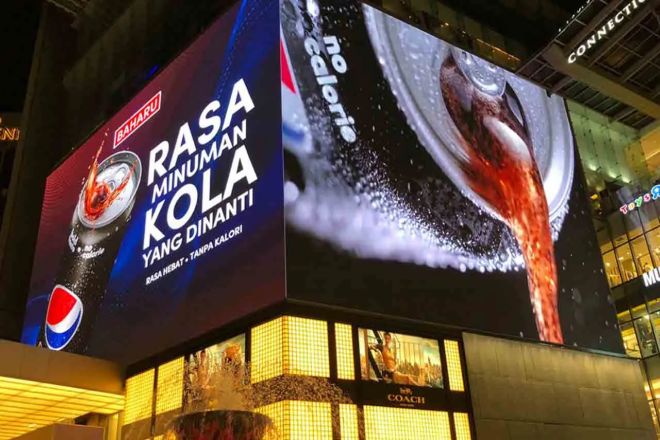
With the continuous expansion of the market, there are many brands and models of écrans d'affichage à LED, and the quality levels are also uneven. For consumers, how to choose an LED display screen that meets their own needs and has excellent quality from this dazzling array of products has become an urgent problem to be solved. Therefore, it is particularly important to master a set of scientific and comprehensive identification skills.
This article distinguishes the advantages and disadvantages of LED displays from 5 aspects!
1. Appearance and structure inspection
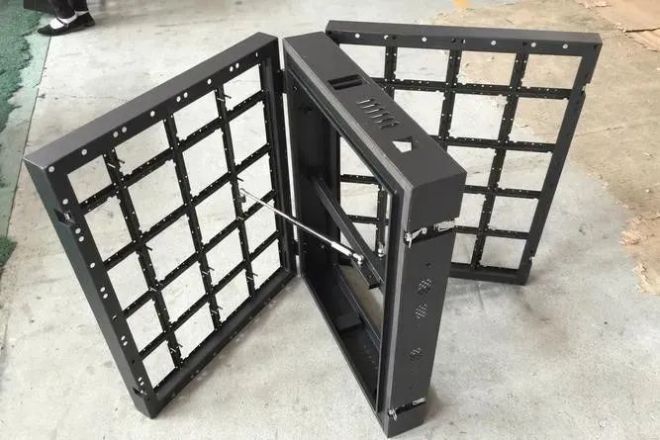
When purchasing an LED display screen, the inspection of appearance and structure is an important part of the initial assessment of its quality. A high-quality LED display screen should not only excel in display effects, but also show its professionalism and ingenuity in appearance and structural design.
1). Appearance integrity
In the selection process of LED display screens, appearance integrity is the primary and intuitive evaluation criterion. It is not only about the first impression of the product, but also a direct reflection of the product quality and craftsmanship.
2). Screen surface flatness and finish
Imagine that in a busy commercial district, an LED display screen is playing fascinating advertising content. If there are bumps, depressions, or obvious scratches on the screen surface, these defects will not only destroy the overall aesthetics but may also interfere with the audience’s visual experience.
On the contrary, the surface of a high-quality LED display should be as smooth and smooth as a mirror, without any defects.
Such a surface is not only easy to clean and maintain but also ensures the clear presentation of advertising content, leaving a deep impression.
For example, some high-end brands of LED display screens use advanced polishing technology on their surfaces, which can maintain extremely high reflectivity and clarity even under strong light.
3). The fineness of the frame processing
As the frame of the display screen, the processing technology of the frame is equally important. An excellent frame design should fit closely to the edge of the screen to ensure seamless docking and avoid dust and moisture intrusion.
At the same time, the material and color of the frame also need to be coordinated with the overall display screen to show a harmonious and unified beauty. In the market, we can find some well-known brands of LED display screens whose frames are made of exquisite metal materials and are processed by special processes.
They are not only sturdy and durable but also exquisite in appearance, perfectly integrated with the screen surface, and enhance the overall visual effect.
4). Innovation and practicality of the overall design
In addition to the above-mentioned flatness, finish, and frame processing, the overall design of the display screen cannot be ignored. An excellent display screen design should be able to attract the audience’s attention while meeting the needs of practical applications.
In terms of styling, designers can be bold and innovative, combining modern aesthetic trends and practical application scenarios to create a unique display screen appearance.
In terms of color matching, it is also necessary to pay attention to the coordination with the surrounding environment to create a comfortable and harmonious visual atmosphere. For example, in the indoor display areas of some high-end shopping malls, we can see some LED screens with unique designs and rich colors. They not only display exquisite advertising content but also become a beautiful landscape in the mall.
2. LED screen structural stability
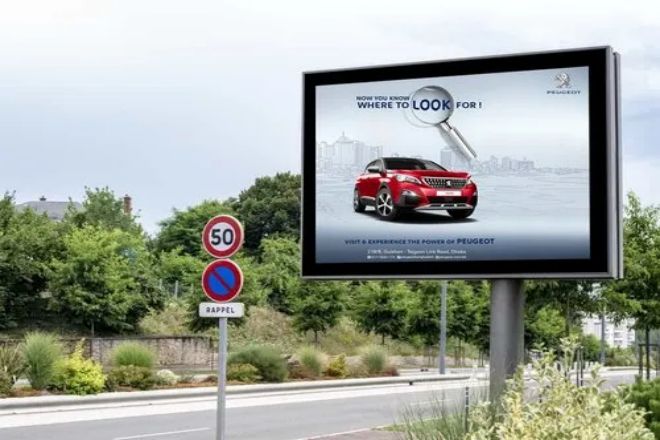
As a large-scale display device, the diversity and complexity of the installation environment of the LED display screen require us to attach great importance to the stability of its structure.
Whether it is on an panneau d'affichage extérieur in a storm or in a crowded stade, a stable structure is the cornerstone to ensure the safe operation and long-term display of the display screen.
1). Material and strength of the bracket
Taking outdoor billboards as an example, the LED display screens there often need to face severe weather conditions such as storms and hail. Therefore, the material selection of the bracket is crucial. High-quality brackets will use high-strength, corrosion-resistant metal materials, such as stainless steel or hot-dip galvanized steel.
These materials not only have excellent load-bearing capacity but also can effectively resist the erosion of the natural environment. Such a bracket design can ensure that the display screen is still as stable as a mountain in harsh environments and is not affected by wind and rain.
2). Precision design and firm installation of connectors
As a bridge between the display screen and the bracket, the design rationality and installation quality of the connector are directly related to the overall stability of the display screen.
Excellent connector design will fully consider the principles of mechanics and adopt precise manufacturing processes to ensure that each connection point can be tightly engaged and impeccable.
At the same time, during the installation process, professional technicians will strictly follow the operating procedures to ensure that the connectors are firmly and reliably installed and will not loosen or fall off during long-term use.
3. LED display cooling system
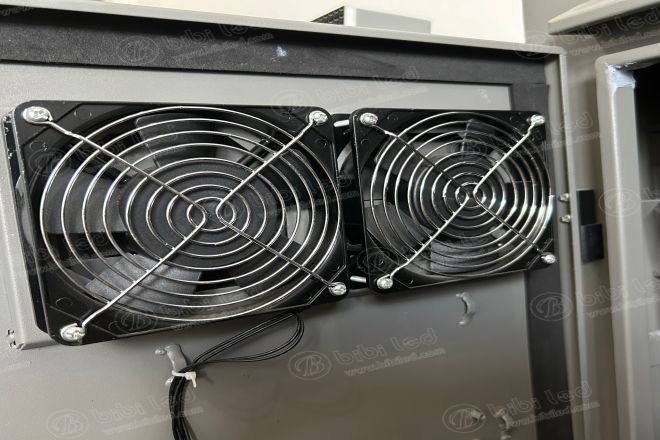
When the LED display screen is working under high-intensity conditions, the internal electronic components will generate a lot of heat.
If the heat dissipation system is not designed properly, heat accumulation will cause the temperature to rise, which will affect the luminous efficiency of the LED lamp beads and the stability of the driving circuit and even shorten the service life of the entire display screen.
Therefore, an efficient and reasonable heat dissipation system is crucial to the performance and life of the LED display screen.
1). Layout and quantity of heat dissipation components
When checking the heat dissipation system, we must first pay attention to the layout and quantity of heat dissipation components, such as heat dissipation fans and heat sinks.
Taking a high-end indoor LED display as an example, its back is designed with multiple high-efficiency heat dissipation fans, which are evenly distributed on the back of the display, forming a good air convection channel.
At the same time, a large area of heat sinks is embedded inside the display. These heat sinks are made of high thermal conductivity materials and can quickly transfer the heat generated by LED lamp beads and other heating components to the air.
This layout not only ensures the effective coverage of the heat dissipation components but also improves the efficiency of heat dissipation.
2). The smoothness of heat dissipation channels
In addition to the layout and number of heat dissipation components, the smoothness of heat dissipation channels is also a key factor in evaluating the performance of the heat dissipation system. High-quality LED displays will carefully design heat dissipation channels to ensure that air can flow smoothly and take away heat.
For example, some high-end display screens use open or semi-enclosed heat dissipation structures. By optimizing the air duct design, the resistance of airflow is reduced, and the heat dissipation efficiency is improved.
In addition, some display screens are also equipped with accessories such as dust screens and filters to prevent dust and debris from entering the heat dissipation channels and affecting the heat dissipation effect.
4. Evaluation of the display effect of LED display
When evaluating the display effect of LED displays, we need to comprehensively consider three aspects: color performance, clarity and details, and dynamic effects. The following will elaborate on these evaluation points through specific examples.
1). Color performance
Color is one of the important elements of the display screen to present images. A high-quality LED display screen should be able to show bright and uniform colors and accurately restore the color details in natural scenes.
For example, when showing a landscape painting, the blue sky on the screen should be clear and bright, the grass should be emerald green, the colors of the flowers should be rich and varied, and the transition should be natural.
If the screen has a color cast, such as blue to purple, green to yellow, etc., it will seriously affect the viewing experience.
In order to evaluate the color performance, we can use professional color calibration tools or software to perform color correction and measurement on the display screen.
At the same time, you can also play some colorful videos or pictures to observe the color reproduction ability and color uniformity of the screen with the naked eye.
2). Clarity and details
Clarity is one of the important indicators to measure the performance of the display screen. A high-quality LED display screen should be able to maintain the clarity of the image at different distances, the edges of the text should be sharp and without jagged edges, and the image details should be rich and delicate.
For example, when displaying a high-résolution document, the text on the screen should be clearly visible, and there should be no blur or distortion, even when it is enlarged to a certain ratio. At the same time, when displaying a delicate image, the screen should be able to present every detail and texture in the image.
To evaluate the clarity and detail performance, we can use high-resolution test images or videos to observe the edges of the text and image details on the screen with the naked eye. Professional image quality analysis tools can also be used for measurement and evaluation.
3). Dynamic effect
The dynamic effect is an important indicator for evaluating the display screen when playing high-speed motion videos or images.
A high-quality LED display screen should have a high refresh rate and high response speed to ensure that there will be no ghosting, blurring, etc., when playing high-speed motion.
For example, when playing an intense sports event, the athletes on the screen should move smoothly and naturally, and they can be clearly presented whether they are running fast or jumping and shooting.
To evaluate the dynamic effect performance, we can play some high-speed motion video clips or game screens and observe with the naked eye whether the moving objects on the screen are smooth and without ghosting.
At the same time, you can also refer to the technical specification sheet of the display screen to understand its parameter information, such as fréquence de rafraîchissement and response speed.
5. Performance and stability test of LED display
In the performance and stability test of LED display screens, we need to conduct a comprehensive evaluation of three aspects, brightness and contrast adjustment, stability test, and environmental adaptability, to ensure the excellent performance of the display screen in practical applications.
1). Luminosité et réglage du contraste
Brightness and contrast are key factors affecting the visual effect of the display screen. Under different lighting conditions, the display screen should be able to flexibly adjust its brightness and contrast to meet the needs of different environments.
During the test, the display screen can be placed in an environment with different light intensities, and its brightness output can be measured using professional equipment such as a photometer, and the contrast can be adjusted through the display screen’s built-in adjustment function to observe whether its adjustment range and effect meet the requirements.
2). Stability test
In the quality inspection process of LED display screens, the performance evaluation of the display screen is particularly critical, which covers multiple aspects such as brightness test, monochrome test, waterproof test, and stability test.
First of all, when conducting a brightness test, it is necessary to measure the maximum brightness value of the display screen in a simulated or actual outdoor environment to ensure that it still has good visibility in a strong light environment.
At the same time, in an indoor environment, its maximum brightness will also be measured to ensure that it is not overexposed and can provide sufficient brightness under indoor lighting conditions.
Next is the monochrome test, which verifies whether the color performance of the display screen is uniform in the four pure color modes of red, green, blue, and white.
By carefully observing the color uniformity of each area of the screen and whether there is a dead light phenomenon and using a color analyzer to detect color saturation and color accuracy, the color reproduction ability of the display screen meets the standard.
The waterproof test is to evaluate the working stability of the display screen in a humid or rainy environment.
According to the waterproof level requirements of the display screen, the factory will use a water spray device to simulate rainwater directly sprayed on the display screen and even conduct an immersion test to check whether its waterproof performance meets the standard and ensure that it can still work normally under severe weather conditions.
Finally, the stability test is an important part of evaluating the reliability and durability of the display screen under long-term operation. We set the display to normal playback mode, including rich colors and dynamic images, and run it continuously for several hours to several days.
During this period, we regularly check its operating status, including whether there are dead lights, flickering, black screen, and other fault phenomena, and record relevant parameters such as temperature and power consumption.
3). Environmental adaptability
LED display screens often need to work under various complex environmental conditions, so their environmental adaptability is one of the important indicators for evaluating their performance.
During the test, the display screen can be placed in different temperature and humidity environments to observe its working performance, especially its performance under extreme conditions.
6. Purchase suggestions
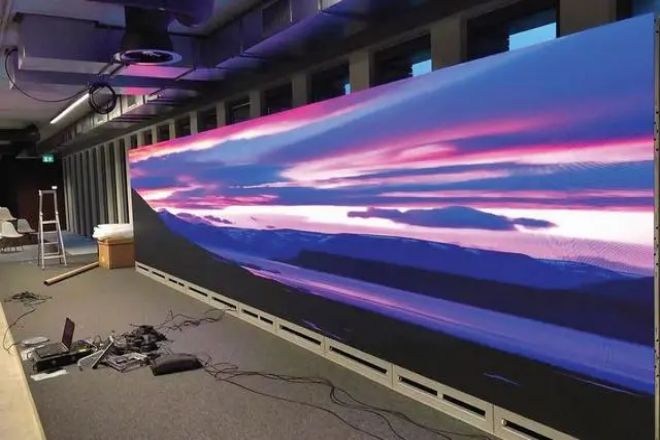
When purchasing LED display screens, considering different application scenarios and needs, the following suggestions will help you make a more informed decision.
1). Identify the application scenario:
Indoor or outdoor: Indoor LED display screens usually have lower brightness requirements, but higher color reproduction and clarity requirements; écrans d'affichage LED extérieurs need to have higher brightness and waterproof and dustproof levels.
Viewing distance: When viewing from a distance, the pixel pitch can be slightly larger; for close distances, high-resolution and high-definition display screens need to be selected.
Ambient light: Higher brightness and contrast are required in strong light environments to ensure the display effect.
2). Budget allocation:
Reasonable planning: According to the overall budget, it is reasonably allocated to the display screen itself, installation costs, maintenance costs, and subsequent upgrades.
Cost-effectiveness considerations: Don’t blindly pursue low prices, but choose products with higher cost-effectiveness while ensuring quality.
Long-term investment: Considering the service life of the display screen and subsequent upgrade needs, choose products with a good brand reputation and after-sales service.
3). Performance requirements match:
Resolution and pixel density: According to the viewing distance and screen size, choose the appropriate resolution and pixel density to ensure a clear and delicate image.
Brightness and contrast: Adjust according to the application scenario to ensure good visual effects under various lighting conditions.
Refresh rate and response time: For occasions where dynamic images need to be displayed, choose a display with a high refresh rate and low response time to reduce smearing and blurring.
4). A little help:
If you are still unsure, I believe the following article can help you!
Conclusion
Through the above analysis and discussion, it is not difficult to find that distinguishing the quality of LED display screens is not a one-time thing, but a comprehensive result that requires comprehensive consideration of multiple factors. From the study of basic knowledge, to the inspection of the appearance structure, to the evaluation of display effects and performance, every link is crucial. At the same time, we cannot ignore the role of brand reputation and after-sales service in ensuring product quality.
Enfin, si vous souhaitez en savoir plus sur les écrans d'affichage LED, veuillez nous contacter.
